One of the major challenges that web developers used to face before 2009 was the limitation of the JavaScript framework to allow only client-side scripting.
In 2009, Ryan Dahl came up with Node.js to make it possible for developers to use JavaScript language to script server-side.
The advantages were exhilarating and in no time, Node.js made its way towards becoming the most preferred environment for custom web development.
In fact, Node.js is now the most common development framework for building frontend and backend for web apps. Don’t believe me? Take a look at the stats below.

Source: https://www.netsolutions.com/
Clearly, you’re not here for all this, you’re here to learn about the best Node.js framework 2021 to work on.
After doing enough research and weighing all the best Node.js frameworks from experience, I have shortlisted the following top 13 Node.js frameworks based on community support, complexity, popularity, ease of usage, and speed.
We will come up with the nodejs frameworks. But first, let’s learn what a Node framework essentially is.
What is a Node.js Framework?
A Node framework is a network of various libraries and tools to provide web developers with a path to develop and operate web applications without complications.
It is the base layer of a web app.
Node.js is a cross-platform, open-source tool, with the help of which developers can build web apps using JavaScript, outside of the limited browser environment.
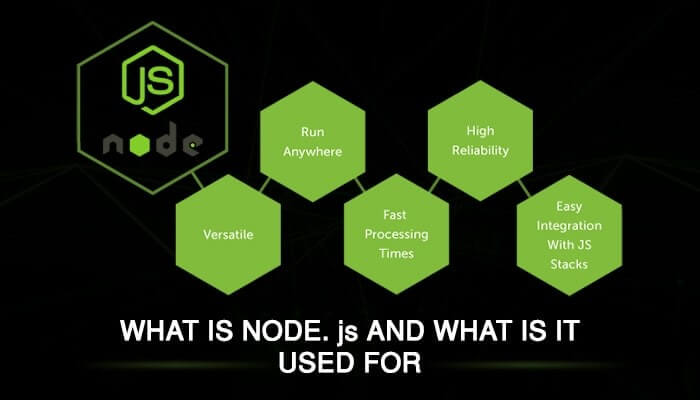
Source: Seer Omega
Some of the benefits include:
- Seamless data streaming
- Real-time working environment
- Simple coding experience
- Same code pattern throughout development
- User-friendly
What are the different varieties of Nodejs frameworks?
If you consider any web-app technology, you will come across different varieties of nodejs frameworks which are further classified under three basic categories – MVC, Full-stack MVC, REST API frameworks.
MVC framework – MVC frameworks are a combination of three essential parts – model, views, and controllers. These frameworks are used in web-app development where splitting of application logic is needed so as to simplify the entire work. One classic example of this framework is Express.js.
Full Stack MVC framework – Full-stack MVC framework comes with scaffolding, libraries, templates, and other development elements. These frameworks are usually used to design real-time applications, taking care of both frontend and backend development. For example, Meteor.
REST (Representational State Transfer) API framework – REST API framework takes care of the architectural styles of network applications and allows interaction with RESTful web services. The REST API built experience makes it easier to develop any app by taking advantage of the existing protocols. For example, Loopback.
The Popularity of the Node.js Framework
If you consider the Nodejs framework web survey report 2018, the framework has increased the productivity of the developers by 68%. It has even reduced the development costs and simultaneously amplified the app performance to a wide extent. Such compelling benefits have excited the developers to adopt and deploy this framework over and over again.
Based on the current development needs, CTOs are leaning towards the frameworks like Express, Meteor, Nestjs, Total.js to reduce the overall cost, resource, and time consumption. The popularity is expected to increase more in the near future.
Still, have a doubt whether the framework is worth it for web app development or not? Here we have listed down some stats and facts. Just have a look.
- 83% of web developers are now preferring the nodejs framework.
- The dynamic framework has cut down the development cost by 58%.
- All popular brands like Amazon, Netflix, eBay, Reddit, LinkedIn are using this framework for better marketing scopes.
- Node.js is found to be ranked 8th among the most used server-side programming languages.
- Node.js support 34 languages in the community.
- Nodejs frameworks are boasting over 55682 stars on GitHub.
Based on the above facts, it is clear that the framework will be dominating the market in the future as well. Hence, there is no wrong to get started with this for your web app development.
Let’s now move on to the best Node.js frameworks of 2019.
Best Node.js Frameworks of 2021
1. Express.js
Excellent for single-page web applications, website, or public HTTP APIs, Express.js is an incredibly fast and minimalist Node.js framework.
It gives developers complete freedom to organize and control their projects as they desire.
Since it is lightweight, it acts as a routing framework.
Here are the top benefits of using Express.js.
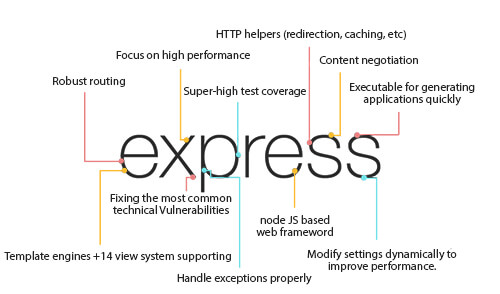
Source: 3E Solutions
For both web and mobile application development, the framework offers exceptional features, providing developers the opportunity to send and receive requests between the front end and the database.
Key Features of Express.js
- Completely customizable
- Easy to understand
- Comes with Model-View-Controller to help create eccentric applications
- Easy setup of middleware to respond to HTTP requests
- Fast I/O and robust API to make routing seamless
- Supports 14+ template engines and offers great performance
Website: https://expressjs.com/
2. Koa.js
Koa.js is another Node.js framework that was made by the engineers behind Express.
It utilizes ES2017 async capacities. It is thought of as a littler, progressively expressive, and increasingly powerful foundation for making web applications and APIs.
In addition, Koa doesn’t package any middleware inside the center.
This means that the middlewares are increasingly streamlined and each line of code is very rich and granular.
Likewise, it grants you to structure the parts in the manner you need.
Here are the highlights of Koa.js.

Source: Cleveroad
Besides, Koa utilizes async capacities to ease the process of error handling.
Key Features of Koa.js
- Reasonable coding experience
- Lightweight architecture
- More customization options
- Limits the use of callbacks to enhance error handling
- Faster coding
- Cleans up messy codes
Website: https://koajs.com/
3. Socket.io
Socket.io is a web-socket structure that can be accessed by various programming languages. The nodejs framework is used to build real-time apps with the intention to create bidirectional communication between web clients and servers.
In NodeJS, Socket.io permits creating web socket applications like chatbots, score tickers, dashboard APIs, and others. This library framework allows chat applications like Whatsapp to run continuously in the background for live updates and messages.
Socket.io has critical advantages over the regular Node.js web application frameworks.
Key Features of Socket.io
- Ability to customize URL routing for web sockets
- Auto-generation of identifiers for all sockets
- Easy socket management
- Seamless Socket authentication
- Can handle servers that don’t support HTTP 1.1
- Real-time analytics
- Binary streaming
- Supports auto-correction, anomaly detection, multiplexing, etc.
Website: https://socket.io/
4. Hapi.js
Built keeping in mind the drawbacks of Express.js (like code organization, module logic, and occasion driven callbacks), Hapi.js is a very stable and reliable Node.js framework.
It is a Node.js REST framework, used to develop Representational State Transfer (REST) APIs.
Hapi.js makes a great replacement for Express.js and offers the exceptional ability to create a server with amazing features (like onPreHandler) on one specific IP.
This makes it the most preferred choice for the Node.js server framework.
Built-in support for I/O validation, caching, authentication, third-party plugins support, and many other features make Hapi.js a preferred Node.js framework.
Moreover, what sets the nodejs framework apart from the rest is that it is the only framework that does not depend on outside help and offers full centralized control over each line of code.
Key Features of Hapi.js
- Easy control over request handling
- Seamless document generation
- Detailed API reference
- Caching, authentication, and input validation made easy
- Plugin-based scaling architecture
- Plugins like the joi, catbox, tv, yar, boom, and travelogue are available
- Efficient error handling
- Lightweight
- Fast and smart
- Can be used with MySQL, MongoDB, and Postgres to develop static websites
- Helps build real-time chat applications
Website: https://hapijs.com/
5. Nest.js
Nest.js is a Node.js framework, which is utilized for building proficient, versatile Node.js server-side applications. It utilizes dynamic JavaScript and is composed with TypeScript.
Being worked with TypeScript implies that Nest accompanies solid typing and consolidates components of OOP (Object Oriented Programming), FP (Functional Programming), and FRP (Functional Reactive Programming).
Nest likewise utilizes Express. It gives an out-of-the-box application design that takes into account the easy making of exceptionally testable, adaptable, loosely coupled, and effectively viable applications.
Nest CLI can be utilized to produce nest.js applications with plenty of highlights.
Key Features of Nest.js
- Better reliability because of TypeScript.
- Provides a modular structure to arrange codes systematically
- Easy front end development on AngularJS because Nest and Angular both use TypeScript
- Features of Express.js
- Unlock amazing features using Nest CLI
Website: https://nestjs.com/
6. Meteor.js
Meteor is a very basic full-stack Node.js system for making mobile just as web applications. It is perfect with web iOS, Android, or desktop. If you are looking for a nodejs framework that uses only one language, Meteor is the right one to choose.
Besides, Meteor also makes application development very rearranged by offering a stage for the total development of the application to be in the same language, JavaScript.
Here’s how it works:

Source: Meteor Blog
Meteor.js has the capacity of serving huge ventures, for example, reaction commerce, which is one of the biggest and most famous eCommerce open-source ventures. It is simple, effective, and makes an ideal choice for modern web app development.
Key Features of Meteor.js
- Possible sharing of the same APIs on the client as well as server-side components
- Lightweight architecture
- Few lines of code required
- Same code for various devices
- Easy integration with React, Angular, Vue, Mongo, etc.
- Backing for sync catchphrases
- Eradicates the need to update mobile apps
Website: https://www.meteor.com/
7. Sails.js
Sails.js is one of the best nodejs frameworks, well-known for a real-time MVC web development Node.js made on Express. The MVC engineering looks like that of Ruby on Rails, supporting a modernized data-oriented development.
Also, it underpins the more current, information-driven style of web application and API development. The interesting this about this lightweight framework is it uses Express for HTTP requests and Socket.io for WebSockets.
Sails.js can create an API bookstore. For example, Sails offers you some essential blueprints, so you don’t have to compose any code.
Take a look at the pros and cons of using Sails.js.
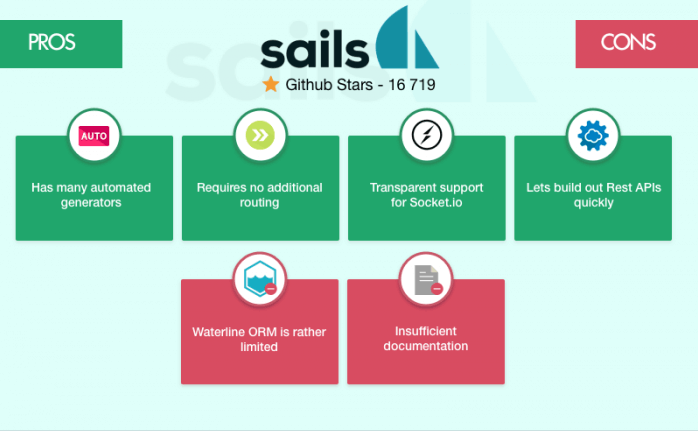
Source: Upwork
Moreover, Sails.js is good with practically all frontend technologies extending from React, Angular, Android/Java, Windows Phone, and so on.
Key Features of Sails.js
- Easy project template generation
- The quick development of object models using the front end
- Easy integration of middleware
- Built-in support for AWS S3 and GridFS
- Offers Object Rational Mapping (ORM) to provide use of all databases
- Highly compatible with front-end web development platforms
- Supports Socket.io
- Hassle-free handling of HTTP requests.
Website: https://sailsjs.com/
8. LoopBack.js
LoopBack is a Node.js framework that offers the freedom to designers to assemble dynamic end-to-end APIs with practically no coding.
With regards to the backend, LoopBack.js furnishes simplicity of incorporation with the vast majority of the databases: Oracle, MySQL, PostgreSQL, MS SQL Server, MongoDB, and SOAP among others.
Here’s how it works;
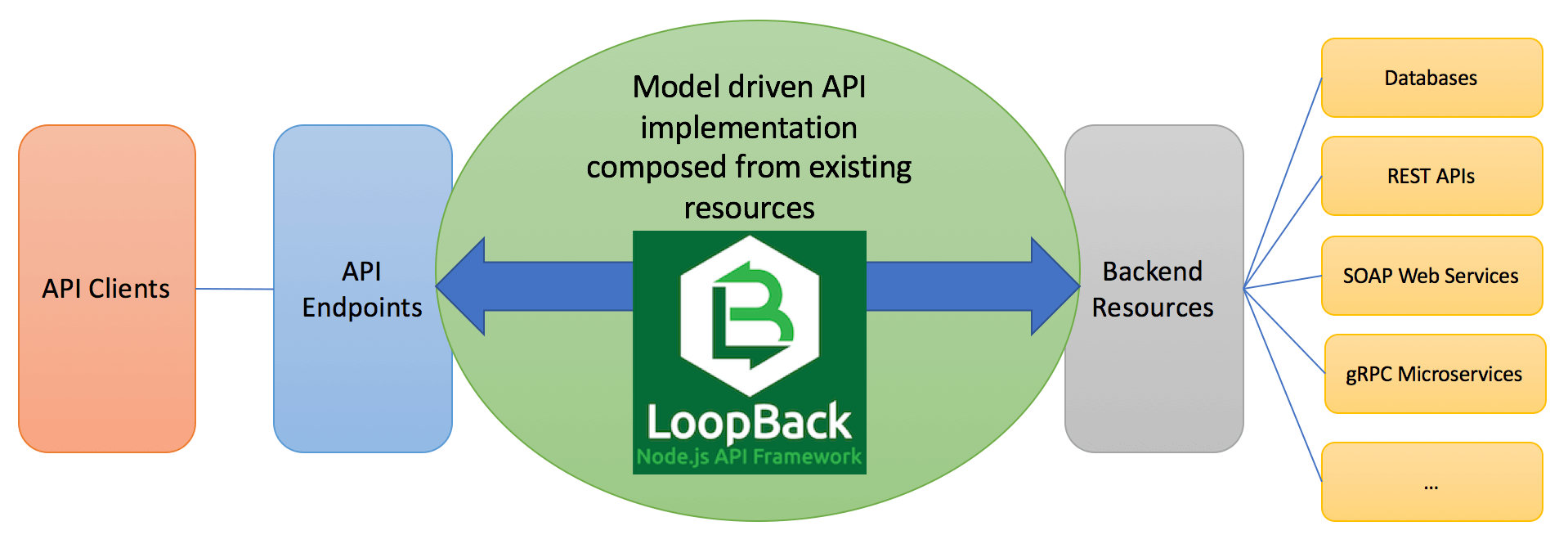
Source: LoopBack
With LoopBack, you get an alternative to run the applications on-premises or in the cloud.
Enormous brands like Bank of America, GoDaddy, and Sapient utilize the LoopBack structure.
Key Features of LoopBack.js
- Rich documentation for speedy development
- Structured code
- Easily connect browsers and devices to data
- Can run on a cloud as well
- Add-ons for file management, third party login
- Has model-relation-support
- Supports multiple databases
Website: https://loopback.io/
9. Derby.js
Derby.Js is an open-source Node.js framework.
It is based on the MVC structure and it is additionally a full-stack Node.js web application framework.
Derby.Js is viewed as perfect for building collective applications.
You can construct both quality web and mobile applications with Derby.Js.
Key Features of Derby.js
- Easy sync of data-time between browsers, servers, and databases
- Self-regulating time to allow multi-users in the same application
- Various editing options
- Work on both client-side and server-side scripts
- Real-time custom website development
- Auto conflict resolution
Website: https://derbyjs.com/
10. Total.js
Total.js brag of being an extremely quick Node.js web application framework that requires little support.
It offers great performance and consistent scaling progress.
So far, the Total.js group has invested some energy attempting to get increasingly premium sponsors to go along with them. This is another sign that they have plans to expand and add additional features.
The nodejs framework presents a CMS-like experience, building an open-source environment granting extreme flexibility to the developers. However, you can find this framework in multiple versions including Eshop, CMS, and Helpdesk. This provides a wider scope in building super-fast applications that require minimal maintenance costs and stable service.
Key Features of Total.js
- Supports various databases like MySQL, MongoDB, and PostgreSQL
- Allows front-end development on Angular, Ember, and React
- Modular code structure and offers features like image processing tool, simple mail transfer protocol (SMTP) system, etc.
- Create real-time responsive apps
- Has the NoSQL database imbedded to offer efficient project development
- Quick prototyping
- Community chat
- Loads of pre-built components for quick and seamless development
Website: https://www.totaljs.com/
11. Adonis.js
Adonis is a well-known Node.js MVC system.
It is profoundly suggested for composing versatile server-side web applications.
As indicated by the official documentation of Adonis.js, it runs on all major OS.
You can undoubtedly compose diverse web applications with Adonis with only a few lines of code.
The best thing about this MVC nodejs framework is it comes up with a steady ecosystem for creating scalable server-side applications. Instead of writing heavy codes, you can use fewer codes for development.
It is basic, simple to utilize, and offers developers a safe development stage.
Key Features of Adonis.js
- Consistent ecosystem to save time
- Easy data handling from databases like Postgres and SQLite
- Easy to learn and adapt to
- The structure is almost as that of Laravel
- Creates efficient SQL queries
Website: https://adonisjs.com/
12. Keystone.js
Keystone.js is a full-stack and open-source system.
Created in Express.js and MongoDB, this amazing structure is utilized for creating database-driven applications, sites, and APIs.
For a considerable length of time, developers have been depending on this system as a confided in buddy because of its adaptable, lightweight, and extensible qualities.
Key Features of Keystone.js
- The UI of this Node.js framework is amazing, customizable, and easy to manage.
- Supports dynamic routes, blocks, and form processing, thus enabling easy development of dynamic websites and applications
- Easy integration with online platforms like Cloudinary, Mandrill, Google Places, etc.
- Stable management to the development progress
- Support for other apps and frameworks like JSP, ASP.NET, WCF, etc.
Website: https://keystonejs.com/
13. Feathers.js
Feathers.js is a quick, small scale service, REST Node.js framework.
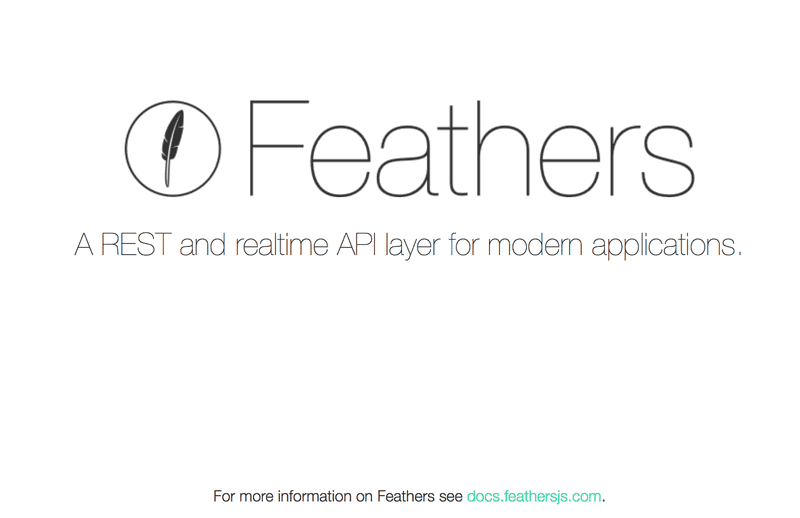 Source: Gorrion
Source: Gorrion
Created on Express.js, it offers users to create present-day isomorphic applications.
Indeed, engineers can, without much of a stretch, make any web application and record any sort of REST API without any preparation because of the adaptable and perfect design this structure underpins.
Key Features of Feathers.js
- Easy access to the modern features of JavaScript because of EXMAScript6
- Share common functionalities between client-side and server-side
- Seamless communication between apps and third-party services.
- Access to relational and non-relational databases.
- Integration of optional plugins
Website: https://feathersjs.com/
Final Thoughts
In the event that there is anything we can pick from this article, I can wager you most certainly understood that picking the best Node.js framework totally depends upon the kind of website or web app you’re planning to build.
With the evolving frameworks and technologies, based on your project requirements and resource availability, it is necessary to choose one among the best nodejs frameworks. Remember, you are confident enough while making your choice.
The Node.js frameworks above have simply given us that whatever structure we are going for, there is an open and inviting network out there comprehending issues and prepared to help you with learning the essentials of that specific structure.
Note that all Node.js frameworks featured in this post were chosen dependent on ubiquity in the JavaScript community, utilization, and personal belief.
